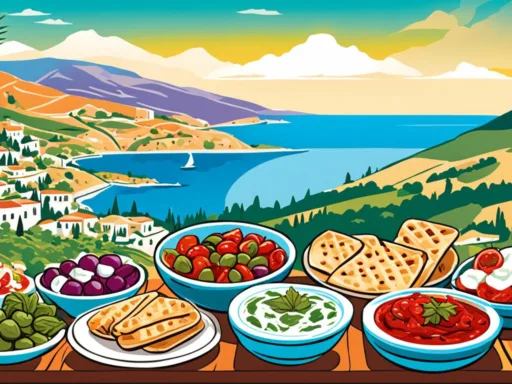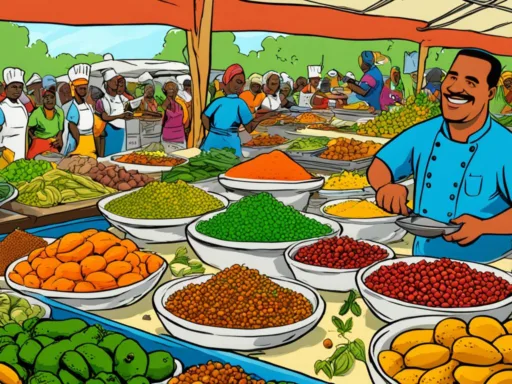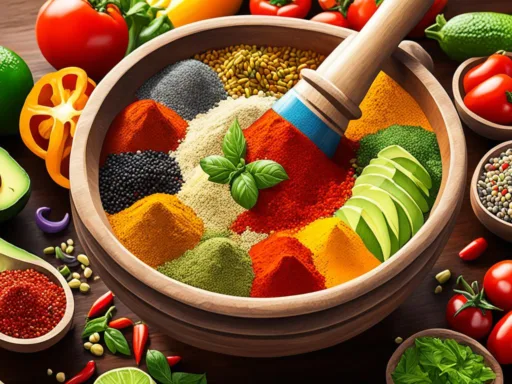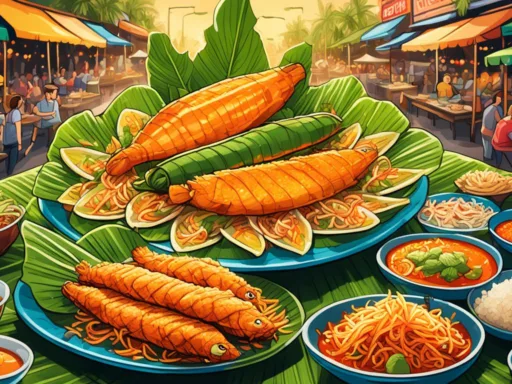Imagine uncovering a treasure trove of flavors where the Sahara meets the Atlantic, a place where every meal is a testament to a nation’s history and its people’s ingenuity. This is the essence of Mauritanian Culinary Discoveries, a realm where the vibrant Mauritanian cuisine—infused with the spirit of North African, Sub-Saharan African, Middle Eastern, and Berber traditions—awaits your palate. Mauritania’s food tapestry is woven with traditional Mauritanian dishes that celebrate the richness of its Mauritanian food culture. With both a generous hand and heartfelt hospitality, local Mauritanian cooking techniques transform simple ingredients into exquisite pleasures. Join us on a journey to unveil the enchanting Mauritanian culinary heritage and explore authentic Mauritanian recipes that exemplify the country’s diverse Mauritanian gastronomy.
Key Takeaways
- Insight into the rich fusion of cultures shaping Mauritanian culinary discoveries.
- Appreciation for the traditional Mauritanian dishes that are staples in local cuisine.
- Understanding the impact of regional ingredients and techniques in Mauritanian cuisine.
- Exploration of the robust Mauritanian food culture through authentic recipes and customs.
- Embracing the heritage behind the cooking techniques that exemplify Mauritanian gastronomy.
An Introduction to Mauritanian Culinary Heritage
The symphony of flavors that defines Mauritanian culinary heritage is both rich and complex. Rooted in a variety of cultural influences, traditional Mauritanian dishes expertly marry local produce with regional spices to produce a unique gastronomic experience. Indeed, the art of Mauritanian cooking techniques is one that cherishes harmony of taste and texture, often showcasing the vibrant ingredients that the land offers.
Mauritanian cuisine employs fundamental staples such as millet and lamb, which are complemented by a colorful palette of spices like cumin and ginger, giving life to dishes that are as aromatic as they are flavorful. Fruits of the oasis like dates introduce a natural sweetness that balances the savory spices in traditional recipes. Vegetables such as okra, onions, garlic, and even peanuts are also pivotal, enhancing the depth and richness of local dishes. Along the coast, fish and tamarind are indispensable ingredients that freshen the palate and link the landlocked traditions with the ample coastlines.
| Ingredient | Role in Mauritanian Dishes | Typical Dishes |
|---|---|---|
| Millet | Grain base in porridges and bread | Aich, Kankossa |
| Lamb | Primary source of protein | Méchoui, Tagine |
| Spices (Cumin, Ginger) | Flavor and aroma enhancement | Mauritanian Yassa, Curry dishes |
| Dates | Sweetener in desserts and sauces | Lekhal, Sweet couscous |
| Fish | Main protein in coastal dishes | Thieboudienne, Fish Tagine |
| Tamarind | Souring agent in sauces and soups | Fish soups, Chutneys |
With an intricate tapestry of ingredients and methods, the Mauritanian culinary heritage is a testament to the adaptability and resourcefulness of its people. It tells a story of a culture that has seamlessly woven the threads of its diverse influences into a quilt of mouthwatering delicacies that continue to evolve, while still remaining true to its roots.
The Fusion of Flavors: North African and Middle Eastern Influences in Mauritanian Cuisine
The scents and flavors of Mauritanian cuisine are a testament to its rich cultural crossroads, where North African zest meets the aromatic depths of the Middle East. The use of Mauritanian spices is not just a tradition; it’s an art that breathes life into every dish. It’s the very essence that captures the country’s storied history and culinary identity.

Spices: The Heartbeat of Mauritanian Flavors
In the Mauritanian kitchen, a myriad of spices converge to create a symphony of flavors like no other. Each spice, whether it be cumin’s warmth, coriander’s citrusy touch, turmeric’s golden hue, the depth of cloves, or mint’s refreshing burst, plays a critical role in the culinary orchestra. Together, these spices shape dishes with a rich and harmonious profile, taking everyday meals to new heights of deliciousness.
Grains and Legumes: Staple Ingredients in Mauritanian Cooking
Integral components of the daily diet, grains in Mauritanian cuisine, such as the versatile millet and the ever-popular couscous, are the foundations of sustenance and pleasure. These grains partner perfectly with an array of legumes in Mauritanian food culture, like okra, adding texture and nutrients to every bite. The presence of grains and legumes is undeniably central to customary recipes, contributing to the defining character of Mauritanian meals.
A closer look at the celebrated Mauritanian dishes like Thieboudienne and Chakhchoukha divulges the necessity of these staples, hand in hand with their respective spices, crafting a culinary narrative that’s warmly inviting and surprisingly complex.
Mauritanian Culinary Discoveries
Embarking on a voyage through Mauritanian cuisine is akin to experiencing a symphony of flavors and traditions, deeply woven into the fabric of Mauritanian food culture. One such melody of tastes is the beloved Thieboudienne, a sensational fish stew that not only satisfies the palate but also encapsulates the warm essence of Mauritanian hospitality. This dish perfectly exemplifies the harmonious blend of fresh catch from the Atlantic, subtly married with tomatoes, spices, and vegetables over a bed of aromatic rice.
Further venturing into the spice-scented lanes of Mauritanian gastronomy, one encounters the fiery Chakhchoukha. Bold in flavors, this dish combines tender chunks of meat with a spicy tomato-based sauce, beautifully absorbed by a bed of rustic bread, offering a taste of the desert’s fortitude with every spoonful.
Mauritanian cuisine also offers a succulent array of meats, lovingly prepared as kebabs and tagines. With each bite, the diverse spices and savory marinades sing accolades to the country’s affinity for meticulously grilled meats and flavors born from a diverse ingredient palette. Below is a glimpse into some of the dishes that shape the dynamic culinary scene of Mauritania:
| Dish | Key Ingredients | Flavor Profile |
|---|---|---|
| Marakh | Lamb, root vegetables, broth | Hearty, comforting |
| Tijéne | Chicken or fish, pumpkin, spices | Earthy, with a hint of sweetness |
| Tagines | Lamb or chicken, dried fruits, nuts, spices | Rich, aromatic |
| Kebabs | Beef or lamb, marinade of local spices | Smokey, with a spice-infused tang |
Your taste buds will revel in the rich stews such as Marakh and Tijéne, where each spoonful is an invitation to indulge in a potpourri of flavors that tell tales of Mauritania’s fertile lands and bountiful seas. The passion for food here goes beyond mere sustenance; it is a heartfelt expression of sharing and togetherness, characteristic of a mealtime approach that nourishes both the body and soul.
Iconic Mauritanian Dishes You Must Taste
Embark on a gastronomic journey through Mauritania and embrace the rich flavors and unique dishes that define the country’s culinary identity. From the beloved national dish to the diverse array of spices enjoyed in local marinades and sauces, every taste tells a story of tradition and technique.
Thieboudienne: Mauritania’s National Dish
At the heart of Mauritanian gastronomy is Thieboudienne, a revered staple that showcases the finesse of combining rice, fish, and vegetables in perfect harmony. This dish exudes a vivid color palette thanks to the vibrant tomato sauce that delicately coats the fluffy grains and succulent fish. Thieboudienne isn’t merely a meal; it’s an experience deeply woven into the fabric of Mauritania’s communal dining culture.

Delving into the Spicy Marinades and Tangy Sauces
No Mauritanian meal is complete without the unforgettable flavors of homemade marinades and sauces that elevate the simplest ingredients to new heights. The complexity of Chermoula, with its intoxicating mix of herbs and spices, imparts a bold taste to grilled seafood and meats. In contrast, the tangy zing of Yassa sauce, with its lemon juice and onion base, brings a zesty freshness that accents the robust textures of Mauritanian dishes. These iconic Mauritanian marinades and sauces are more than just condiments; they’re a testament to the region’s palate, with every spoonful rich in history and flavor.
- Chermoula: A herbal marinade that is synonymous with Mauritanian sealife.
- Yassa: A zesty, onion-based sauce that captures the tangy spirit of the nation.
Whether you’re a connoisseur of world cuisines or a curious foodie looking to expand your horizons, Mauritania’s iconic dishes are a window into the soul of this vibrant culinary landscape. Indulging in Thieboudienne or savoring the spicy and tangy notes of local marinades and sauces is essential for anyone seeking to understand and appreciate the rich, multifaceted flavors of iconic Mauritanian dishes.
Exploring the Street Foods of Mauritania: A Taste of Local Life
Undeniably, a culinary exploration through Mauritania is incomplete without savoring the Mauritanian street food that graces its bustling marketplaces. These flavorful offerings provide a window into the heart of local Mauritanian cuisine, showcasing the country’s rich heritage through each bite-sized delight.
Meandering through the streets, one can encounter the irresistible aroma of Boulette, the famed deep-fried fish balls seasoned with an array of local spices, epitomizing the culinary ingenuity of the Mauritanian people. This quintessential street fare exemplifies the communal vibe of Mauritanian food culture, bringing locals and travelers together in a shared gastronomic experience.
- Fried pastries filled with meat, onions, and spices
- Grilled skewers of marinated lamb or beef
- Fluffy, round loaves of bread served with varied spreads
- Sweet treats soaked in honey, often topped with sesame seeds
These gastronomic gems are more than just sustenance; they are a celebration of everyday life in Mauritania, telling tales of tradition and togetherness. To truly grasp the depth of this nation’s culinary identity, one must dive into the vibrant scene of Mauritanian street food and partake in the timeless ritual of open-air feasting.
Whether you are a food enthusiast or a curious traveler, the culinary exploration of Mauritanian street eats is an adventure that promises a tapestry of flavors and a heartfelt connection to the local way of life.
The Art of Mauritanian Cooking Techniques
The rich flavors and authentic dishes of Mauritania are the products of deeply rooted Mauritanian cooking techniques and traditional Mauritanian culinary methods which have been honed and passed down through generations. Whether it is the slow simmering of stews that lure you in with their fragrant aromas or the rustic appeal of bread freshly baked in earth ovens, every preparation is a testament to the time-honored practices of this vibrant culture.
Integral to the nation’s culinary practices are the harmonious methods of cooking that often involve several steps and elements working together to create wholesome and flavorsome meals. Among these methods are the slow-cooking of tagines, a Moroccan influence that has made its way into the heart of Mauritanian gastronomy. These earthenware pots are central to the process of melding spices, meats, and vegetables into tender, aromatic stews.
| Technique | Method | Common Dishes |
|---|---|---|
| Grilling | Open flame cooking, often on a gridiron over wood or charcoal | Grilled fish, Kebabs |
| Stewing | Gentle simmering of ingredients in a liquid to create a flavorful dish | Thieboudienne, Marakh |
| Baking | Using dry heat within a closed environment, such as an earth oven | Lekhal, flatbreads |
| Slow-Cooking | Cooking at a lower temperature for a long duration, allowing flavors to develop | Tagine dishes |
These techniques do more than cook food; they imbue each dish with a sense of place and history that is palpably Mauritanian. In a chorus of crackling flames and bubbling pots, the timeless narrative of the nation’s heritage is told. The role of food in Mauritania stretches far beyond mere nourishment; it is a form of expression, a way of life, and a bridge that connects the past to the present.
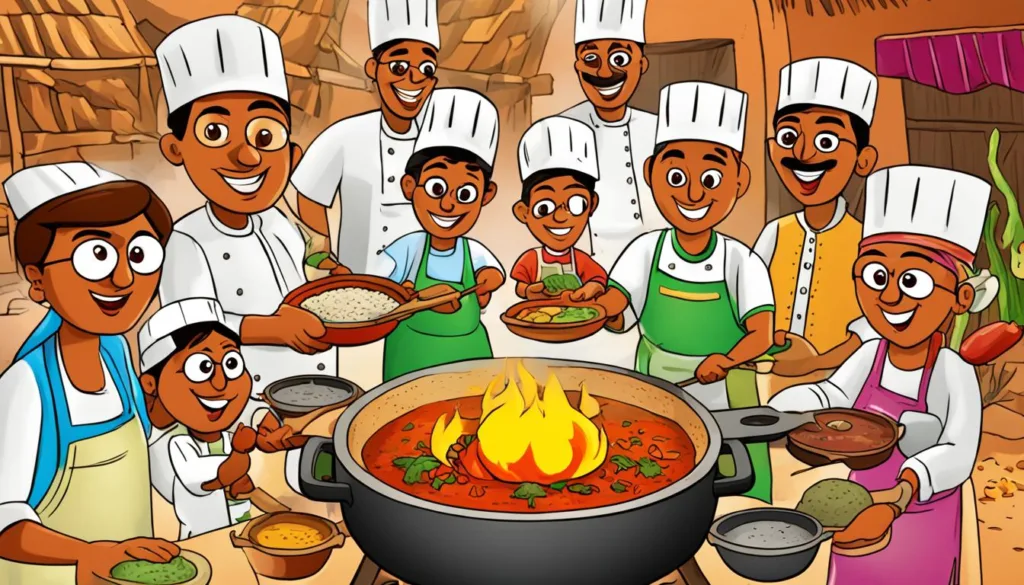
Mauritanian cuisine is not simply about employing these techniques independently; it is also about the artistry with which they are combined. For instance, fish might be marinated with freshly ground spices before being grilled to perfection, creating a smoky and spicy delicacy that is both earthy and refined. Through this intricate dance of flavors and methods, Mauritanian cooks are not only chefs but also guardians of age-old culinary traditions.
The passion for sharing and the sheer joy of creation are embedded in every aspect of Mauritanian culinary methods. When a meal is served, it is an invitation to experience the Mauritanian way of life, where every morsel tells a story of community, love, and hospitality – a true art form in every sense.
Mauritanian Gastronomy: A Reflection of Coastal and Desert Cultures
The culinary landscape of Mauritania is a fascinating testament to its geographical diversity, where the abundant Atlantic coastline meets the sprawling Sahara. The savory aromas of Mauritanian seafood dishes waft through the bustling coastal markets, while the interior’s desert plains give rise to desert-inspired Mauritanian meals that tell tales of resilience and adaptation. This medley of environments shapes a coastal Mauritanian gastronomy that is as rich as it is varied, offering a palate of flavors that reflect the country’s storied history and multicultural influences.
Seafood Delicacies Along the Coast
Skirting the shores of the Atlantic, Mauritanian chefs are masters of seafood preparation, transforming fresh catch into exquisite meals. Grilled, stewed, or baked, the preparation of seafood is a revered art form here. Diners can relish succulent lobsters, tender octopus, and various fish species, each meal underscoring the freshness and simplicity of coastal life. The Mauritanian approach to seafood thrives on minimalism, expertly using herbs and spices to accentuate natural flavors rather than overwhelm them.
The Richness of Desert-Inspired Mauritanian Cuisine
Take a journey inland, and the influence of the Sahara emerges in striking contrast to the coast’s bounty. Here, desert-inspired dishes draw on the nomadic traditions of the region, employing slow-cooking techniques that coax complex flavors from simple ingredients. Meats are often marinated with aromatic spices before being cooked to perfection in sand pits, a method that imparts an earthy smokiness that has become synonymous with Mauritanian hospitality. The emphasis on communal dining further enriches these meals, providing a shared experience that’s central to the nation’s cultural ethos.
| Dish Type | Key Ingredients | Cooking Method | Flavor Profile |
|---|---|---|---|
| Coastal Seafood | Fish, crustaceans, mollusks | Grilling, stewing | Fresh, herb-infused, lightly spiced |
| Desert Cuisine | Lamb, root vegetables, grains | Slow-cooking in sand pits | Robust, earthy, deeply aromatic |
The culinary mosaic of Mauritania, from desert to coast, beckons food enthusiasts to explore its varied menu. Whether it’s savoring a plate of meticulously prepared seafood by the shore or enjoying a hearty, desert-inspired stew under the stars, every dish embodies the land’s narrative and evokes the soul of its people.
Authentic Mauritanian Recipes for the Home Cook
Unlock the secret to Mauritanian cooking at home with beloved recipes that capture the spirit of the Sahara. Whether a seasoned chef or a culinary novice, these dishes bring the warm aromas of Mauritania into your very own kitchen, promising an exceptional gastronomic voyage. Delight in preparing authentic Mauritanian desserts and savory meals that merge the richness of dates, the crunch of nuts, and the profound spices that make this cuisine so distinctive.
Bringing Mauritanian Flavors to Your Kitchen
Embark on a gourmet adventure with Mauritanian recipes that have been tailored for the home cook. Enrich your menu with Lekhal, an enchanting date pastry, or the creamy delicacy Ruz Bel Hleeb, infused with cardamom. These authentic Mauritanian recipes encapsulate an array of textures and flavors that are deeply rooted in the nation’s culinary tradition.
Cooking with Dates and Nuts: A Sweet Twist
Indulge in desserts that shine a spotlight on the sweet side of Mauritanian cuisine. Seamlessly integrating dates and nuts, these confections are not only an after-dinner treat but also a nutritious snack. Master the creation of rich, sweet pastries and desserts that delight the palate and pay homage to Mauritanian cooking traditions.
| Dessert | Key Ingredients | Flavor Profile |
|---|---|---|
| Lekhal | Dates, Semolina flour, Honey | Sweet, Rich, Hint of Honey |
| Ruz Bel Hleeb | Rice, Milk, Cardamom, Rosewater | Creamy, Fragrantly Spiced |
| Maarek | Dates, Almonds, Sesame Seeds | Nutty, Chewy, subtly Sweet |
Dive into the joys of Mauritanian desserts that offer a perfect finale to any meal. Aspiring chefs and lovers of unique sweets can now recreate these authentic Mauritanian recipes with ease, allowing the family to gather around for a taste of Mauritania’s cherished culinary creations.
Mauritanian Cuisine: A Culinary Adventure in Nouakchott and Beyond
Embark on a Mauritanian culinary adventure that transcends the bustling streets of Nouakchott to the serene deserts of Atar. Unravel the intricate tapestry of Nouakchott cuisine, which promises a delight for seafood aficionados, while experiencing the bold and hearty flavors of the regional Mauritanian dishes found throughout the country’s diverse landscape.
The regional specialization of Mauritanian cuisine is not merely about the ingredients; it’s a cultural narrative told through taste and tradition. Here are the regional specialties that make up the rich culinary landscape:
| Region | Specialty Dish | Key Ingredients |
|---|---|---|
| Nouakchott | Grilled Seabream | Seabream, Lemons, Spices |
| Nouadhibou | Stuffed Squid | Squid, Rice, Herbs |
| Atar | Zrig | Camel Milk, Dates, Mint |
Exploring the heart of Nouakchott, you’ll find streets lined with vendors serving the day’s catch, cooked to perfection with a blend of spices that will leave your palate yearning for more. Venture inland, and the stark beauty of the desert regions unveils a different side of the Mauritanian culinary adventure. Here, the cuisine is a testament to the resourceful approach to cooking, producing flavors that are as intense and surprising as the landscape itself.
Whether you’re indulging in the seafood wonders of Nouakchott or sampling the desert-infused delicacies of Atar, each bite is a step further in an exhilarating journey through Mauritania’s culinary heritage. So, prepare your taste buds for a truly sensorial sojourn, one that encapsulates the essence of regional Mauritanian dishes and the adventurous spirit that defines them.
Conclusion
Embarking on a journey through Mauritanian cuisine is to step into an aromatic landscape where every meal is a reflection of history and heart. This exploration affords us a kaleidoscopic view of the culinary richness that Mauritania harbors. From the sun-soaked coastlines, with their affinity for fresh seafood, to the whispering sands of the desert, where ancient cooking techniques triumph, the country’s gastronomy weaves an intricate story of culture, survival, and artistry. It reveals not just a variety of flavors but the very soul of the Mauritanian people.
The traditional recipes and cooking methods seen throughout our journey are a testament to the nation’s prodigious Mauritanian culinary heritage. Each dish encountered, narrates a chapter of an age-old tapestry that continues to thrive in modern times. As we witnessed, Mauritanian dishes offer more than just sustenance; they serve as communal bonds, inviting shared experiences that are hallmarks of the nation’s hospitable ethos. This inherent joy of sharing reflects Mauritanian’s reverence for food, celebrating it as an essential thread in the fabric of their society.
In sum, the Mauritanian Culinary Discoveries encountered on this epicurean voyage are profound. They don’t merely fill the plate; they enchant the palate and enrich the mind with an understanding of a faraway place where food is revered as both heritage and celebration. With its vast tapestry of tastes, textures, and aromas, the appreciation for Mauritanian gastronomy beckons gourmet enthusiasts and curious explorers alike to delve deeper into the delectable and storied cuisine of this hidden gem in the landscape of international flavors.
FAQ
What are some traditional Mauritanian dishes?
Traditional Mauritanian dishes include Thieboudienne (a fish and rice stew), Marakh (a meat and vegetable stew), Tijéne (a slow-cooked meat dish), Boulette (deep-fried fish balls), and various spiced kebabs and tagines. These dishes reflect the diverse influences in Mauritanian cuisine.
How do North African and Middle Eastern influences appear in Mauritanian cuisine?
North African and Middle Eastern influences manifest through the use of spices like cumin, coriander, turmeric, and mint, and staples such as couscous and millet. These regional flavors contribute to the aromatic and savory profiles characteristic of Mauritanian dishes.
What is considered the national dish of Mauritania?
The national dish of Mauritania is Thieboudienne, which is a flavorful stew made with fish, rice, and vegetables, typically seasoned with a hearty tomato sauce. It’s a symbol of Mauritanian hospitality and is widely enjoyed throughout the country.
Are there any unique cooking techniques in Mauritanian cuisine?
Yes, Mauritanian cooking techniques include grilling over open flames, stewing in traditional pots, and slow-cooking in tagines. Additionally, techniques adapted to the desert environment, such as cooking meats in sand pits, are also an integral part of the culinary tradition.
Can you find seafood dishes in Mauritanian cuisine?
Definitely, seafood is a big part of Mauritanian cuisine, especially along the coast in cities like Nouakchott. Fresh fish grilled, stewed, or used in dishes like Thieboudienne represents the rich seafood culture of the region.
Which spices are commonly used in Mauritanian cuisine?
Common spices in Mauritanian cuisine include cumin, ginger, coriander, turmeric, cloves, and mint. These spices add depth and complexity to dishes, embodying the culinary fusion of African and Middle Eastern flavors.
What are some popular Mauritanian street foods?
Popular Mauritanian street foods include Boulette (fried fish balls), grilled meats, savory pancakes, and spiced potatoes. These foods offer insight into the everyday culinary life and the social aspect of dining in Mauritania.
How does the desert influence Mauritanian cuisine?
The desert influences Mauritanian cuisine by privileging robust, hearty flavors and cooking methods that make the most of limited resources. Techniques such as sand-pit cooking and the use of dried staples like dates and millet cater to the arid conditions, creating a distinct desert culinary heritage.
Are there Mauritanian desserts that feature dates and nuts?
Yes, dates and nuts are prominent in Mauritanian desserts. Sweet treats like Lekhal (date-filled pastries) and Ruz Bel Hleeb (a cardamom-scented rice dessert with nuts) showcase how these ingredients can be used to create deliciously sweet endings to meals.
What culinary experiences can you expect in Mauritanian cities like Nouakchott?
In Nouakchott and other Mauritanian cities, one can expect a variety of culinary experiences reflecting the coastal and inland influences. Seafood dishes are prevalent in Nouakchott, while inland cities may offer more meat-centric fares, collectively contributing to the gastronomic adventure of the region.



